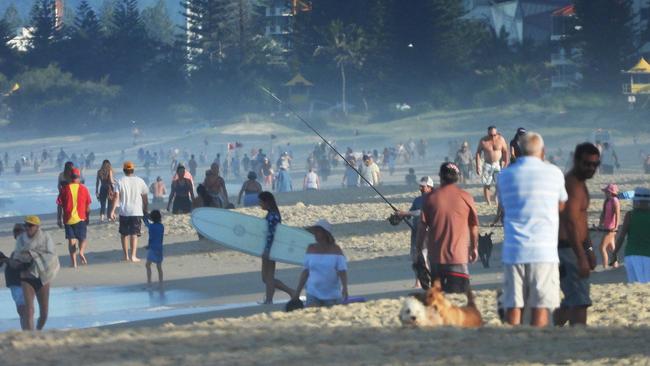Peak passed, but not yet on downhill run
Australia appears to have passed its peak and is faring better than many other nations “by a factor of hundreds”.

Australia appears to have passed its peak of coronavirus infections more than a fortnight ago, and is faring better than many other nations “by a factor of hundreds” in efforts to combat the disease.
According to modelling figures obtained by The Australian that compare international infection rates based on size of population, the Morrison government’s co-ordinated strategy with the states to “flatten the curve” of COVID-19 in the community is working.
Updated figures compiled by Emilio Ferrer, a Sydney-based data analysis expert, indicate Australia reached its peak of infection about March 30, with the estimate of cases now at 25.5 per 100,000 people.
New Zealand’s infection rate is similar, having peaked around April 6 and now recording case numbers just slightly higher at 28.8 per 100,000 people or fourth-lowest in the world after aggressive COVID-19 containment measures adopted by the Ardern government.
Japan is rated No 1 in its push to control coronavirus with an estimated 9.4 cases per 100,000 people, despite some signs of a possible second wave of infection, followed by China with 15.9.
Mr Ferrer, a former NSW health official and Labor staffer and now a mathematical modelling researcher, said some caution was needed in accepting China’s rates despite its tough government measures to contain the spread because of the high concentration of infection in Wuhan, where the disease originated and recent reports that numbers had been significantly underestimated.
He said Australia had performed remarkably well, despite early criticism of the Morrison government for being slow to react, as comparisons showed it was ahead of many other nations by “a factor of hundreds”.
Mr Ferrer said Australia’s success appeared based on the combination of a strong health system, good government policy and the way people had responded.
“The federal and state governments have been very responsible, not bragging about it,” he said.
“In politics, there is a temptation to say ‘I’m doing really well’, but Scott Morrison hasn’t done that, and the premiers haven’t done that.
“The first thing that has helped us is co-ordination, establishing the national cabinet. That is what is not happening in the US where (Donald) Trump is fighting with state governors, setting himself up to say the governors killed the economy. That would be irresponsible here, because you can’t really kill the epidemic in NSW but not in Victoria. It will come again.”
As the number of new cases fell on Monday, raising hopes that several thousand extra hospital intensive care beds might not be needed for those seriously ill, our COVID-19 tally reached 6617, with 4124 recoveries and 73 deaths.
The US has the highest number of recorded cases at 759,696, followed by Spain (198,674), Italy (178,972) and France (154,098).
Mr Ferrer, who heads health and education research firm Sphere, said his modelling used a multiplier to make international comparisons based on the number of deaths related to COVID-19 in each country, and their stated number of confirmed infections.
Based on estimates of health experts around the globe, he used an average figure of 1.1 per cent fatalities from the disease in his calculations. Unlike Ebola, from which most people died, he said COVID-19 was not usually fatal.
Variations between countries that showed vastly higher deaths were put down to lower testing rates, leading to an underestimation of actual cases.
The figures for Australia, which had high testing levels and a relatively low number of deaths for the tally of reported cases, were based on a multiplier of one compared with a multiplier of between three and almost nine for countries with low testing levels, where death rates were very high compared with the number of reported cases. A multiplier of one meant case numbers were accepted at face value in calculations.
Mr Ferrer said Australia’s weekly average rate of infections, after peaking at the end of March, was now “well on the way down”. While rates in NSW were still the highest, Tasmania’s could exceed it soon based on population levels.
“No one individual thing can be given credit, but I think government has done a number of things that are very good. They have put the experts in charge … the best-practice way to manage an epidemic. The message … is to keep doing what you are doing, stay calm, it is working. If you take these positive signs as an excuse to go out, there are plenty of examples of … a second wave.”
With South Korea and New Zealand most similar to Australia in the way their governments had handled the pandemic with social distancing, testing and compulsory isolation for confirmed cases, Mr Ferrer said reported numbers in these nations were largely accurate and attracted a multiplier close to one.
Despite earlier signs Singapore was containing its virus spread, there were emerging signs from trend figures of a second wave, he said. Nations that performed well all had high testing levels and lower fatality rates.
While very high rates per 100,000 people were recorded for countries including Spain, Italy, France, Britain and the US, Mr Ferrer said Belgium surpassed them all with more than 2800 per 100,000 people — a rate almost 130 times that of Australia’s.
The modelling has been shared with health authorities in a number of other nations.







To join the conversation, please log in. Don't have an account? Register
Join the conversation, you are commenting as Logout